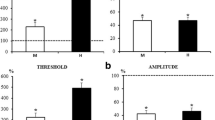Summary
A report is offered in the present work concerning electromyographic tests of the gluteal and adductor muscles in 10 patients suffering from hip arthrodesis, who have experienced stiffening of the hip from 3 to 12 years. Here it has been shown that even years consequent to a completed hip stiffening operation on the monarticular muscles of the hip-joint a degree of innervation is to be demonstrated both in standing as well as in going that corresponds to the normal.
The electromyographic test of the homolateral monoarticular muscles of the hip-joint is a very good aid for the indication situation regarding a remobilisation operation after hip arthrodesis, while what has been asserted as a result of this concerning the standing leg question is only to be considered with reservation, allowing a definite statement to this problem only in particular cases.
Zusammenfassung
In der vorliegenden Arbeit wird über elektromyographische Untersuchungen der Gluteal- und Adductorenmuskulatur bei 10 hüftarthrodesierten Patienten berichtet, bei denen die Hüftversteifung 3–12 Jahre zurücklag. Es zeigte sich hierbei, daß auch Jahre nach durchgeführter Hüftversteifungsoperation an den monartikulären Muskeln des Hüftgelenkes ein mit dem Normalen übereinstimmendes Innervationsschema sowohl im Stand als auch beim Gehen nachzuweisen ist.
Die elektromyographische Untersuchung der homolateralen monartikulären Muskeln des Hüftgelenkes ist eine sehr gute Hilfe für die Indikationsstellung zur Remobilisationsoperation nach Hüftarthrodese, während die hierdurch gewonnenen Aussagen bezüglich der Standbeinfrage nur mit Vorbehalt zu verwerten sind und nur im Einzelfall eine reelle Aussage zu dieser Problematik erlauben.
Similar content being viewed by others

Literatur
Baumann, F.: Das elektromyographische Verhalten festgestellter Muskeln nach Arthrodese. Verh. dtsch. orthop. Ges. 54, 107 (1967)
Baumann, F., Behr, O.: Elektromyographische Untersuchungen der Hüftmuskulatur nach Arthrodese. Arch. orthop. Unfall-Chir. 66, 1–17 (1969)
Breitenfelder, J.: Die Hüftgelenksarthrodese — eine klinische und experimentelle Studie zur Zweckankylose des Hüftgelenkes. Habilitationsschrift, Julius-Maximilians-Universität Würzburg 1974
Breitenfelder, J.: Das elektromyographische Verhalten der Gluteal- und Adduktorenmuskulatur im Arthrodesensimulationsversuch des Hüftgelenkes. Arch. orthop. Unfall-Chir. 82, 299–304 (1975)
Buchthal, F.: Einführung in die Elektromyographie. München: Urban & Schwarzenberg 1958
Burckhardt, A., Taillard, W.: Die Statik und Dynamik der versteiften Hüfte. Z. Orthop. 111, 710–723 (1973)
Cruveilhier, H.: Traité d'anat. path. géen. 3. Paris 1856
Drechsler, B.: Elektromyographie. Berlin: Volk und Gesundheit 1964
Inman, V. T.: Functional aspects of the abductor muscles of the hip. J. Bone Jt Surg. 29-A, 607–619 (1947)
Lindsley, D. B.: Elektromyography studies of neuromuscular disorders. Arch. Neurol. (Chic.) 36, 128–157 (1936)
Pauwels, F.: Beitrag zur Klärung der Beanspruchung des Beckens, insbesondere der Beckenfugen. Z. Anat. Entwickl.-Gesch. 114, 167–181 (1949/50)
Scherb, R.: Kinetisch-diagnostische Analyse von Gehstörungen. Technik und Resultate der Myokinesiographie, Suppl. 82 (1952)
Senn, O.: Das Fächersymptom der Glutealmuskulatur. Z. Orthop. 98, 299–320 (1964)
Seyffarth, H.: Electrical responses of single motor units in the biceps muscle in a case of traumatic lesion of a musculo-cutaneous nerve. Acta psychiat. scand. 13, 297–331 (1938)
Smith, J. W.: Observations the postural mechanism of the human knee joint. J. Anat. 90, 236–260 (1956)
Steindler, A.: Kinesiology of the human body. Springfield (Ill.): Charles C. Thomas 1955
Author information
Authors and Affiliations
Rights and permissions
About this article
Cite this article
Breitenfelder, J. Elektromyographische Untersuchungen der Gluteal- und Adductorenmuskulatur nach Hüftarthrodese. Arch orthop Unfall-Chir 83, 279–287 (1975). https://doi.org/10.1007/BF00416281
Received:
Issue Date:
DOI: https://doi.org/10.1007/BF00416281



